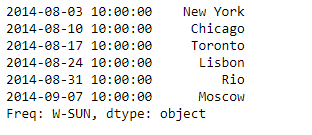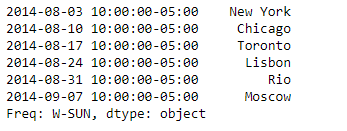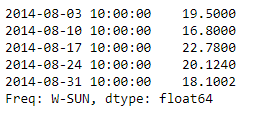Python Pandas Series.tz_localize
Python是一种进行数据分析的伟大语言,主要是因为以数据为中心的Python包的奇妙生态系统。_Pandas _是这些包中的一个,使导入和分析数据变得更加容易。Pandas系列是一个带有轴标签的一维ndarray。标签不需要是唯一的,但必须是一个可散列的类型。该对象同时支持基于整数和标签的索引,并提供了大量的方法来执行涉及索引的操作。Pandas Series.tz_localize()函数用于将一个系列或数据框架的tz-naive索引定位到目标时区。这个操作将索引本地化。为了使不含时区的系列中的数值本地化,我们可以使用Series.dt.tz_localize()。
语法: Series.tz_localize(tz, axis=0, level=None, copy=True, ambiguous='raise', nonexistent='raise')
**参数 : **
tz : string or pytz.timezone object
axis : the axis to localize
level : If axis is a MultiIndex, localize a specific level.否则必须是 None
copy : 也会复制一个基础数据
ambiguous : ‘infer’, bool-ndarray, ‘NaT’, default ‘raise’
nonexistent : str, default ‘raise’
返回: Series or DataFrame
例子#1:使用Series.tz_localize()函数,将给定系列的时区奈何指数定位到目标时区。
# importing pandas as pd
import pandas as pd
# Creating the Series
sr = pd.Series(['New York', 'Chicago', 'Toronto', 'Lisbon', 'Rio', 'Moscow'])
# Create the Datetime Index
didx = pd.DatetimeIndex(start ='2014-08-01 10:00', freq ='W',
periods = 6)
# set the index
sr.index = didx
# Print the series
print(sr)
输出 :

现在我们将使用Series.tz_localize()函数来将给定的时区天真索引本地化为时区感知索引。目标时区是 “美国/中部”。
# Localize to 'US / Central'
sr.tz_localize('US/Central')
输出 :

我们可以在输出中看到,Series.tz_localize()函数已经将给定的天真时区指数转换为时间感知指数。
例子2:使用Series.tz_localize()函数将给定的Series的时区天真索引定位到目标时区。
# importing pandas as pd
import pandas as pd
# Creating the Series
sr = pd.Series([19.5, 16.8, 22.78, 20.124, 18.1002])
# Create the Datetime Index
didx = pd.DatetimeIndex(start ='2014-08-01 10:00', freq ='W',
periods = 5)
# set the index
sr.index = didx
# Print the series
print(sr)
输出 :

现在我们将使用Series.tz_localize()函数来将给定的时区天真索引本地化为时区感知索引。目标时区是’Asia/Calcutta’。
# Localize to 'Asia/Calcutta'
sr.tz_localize('Asia/Calcutta')
输出:

 极客教程
极客教程